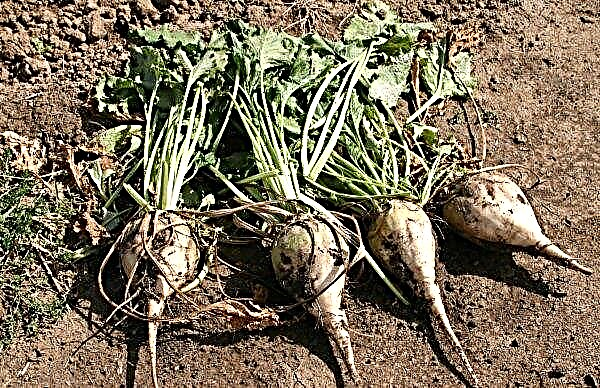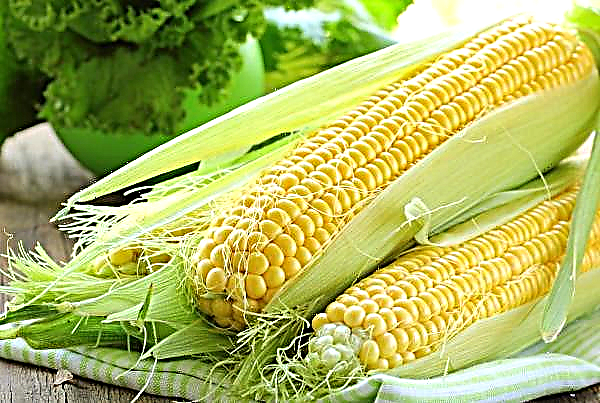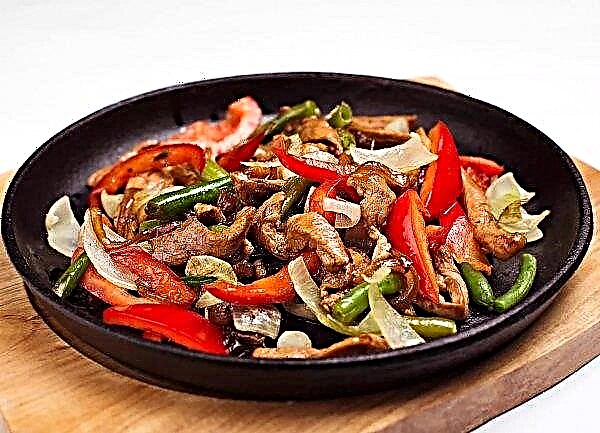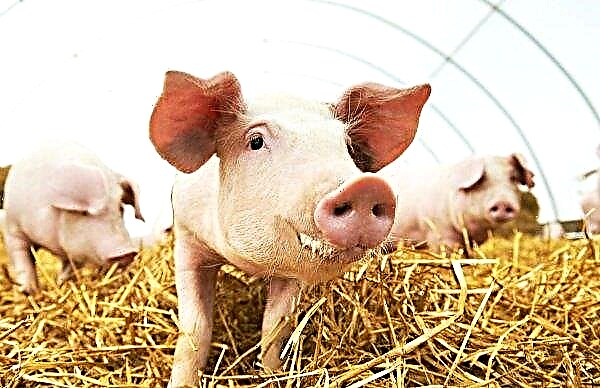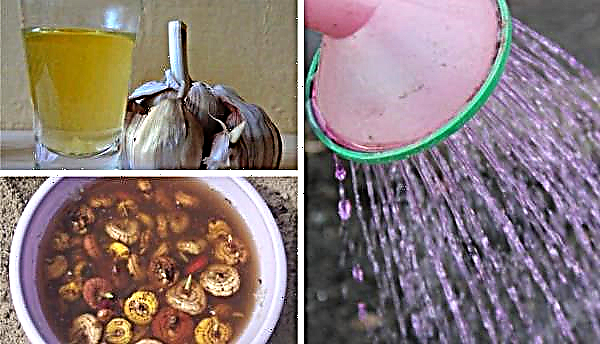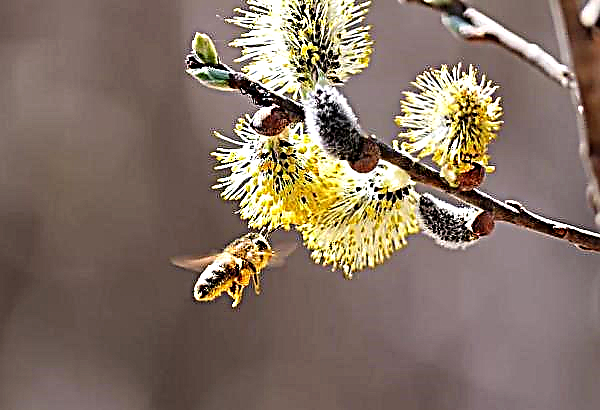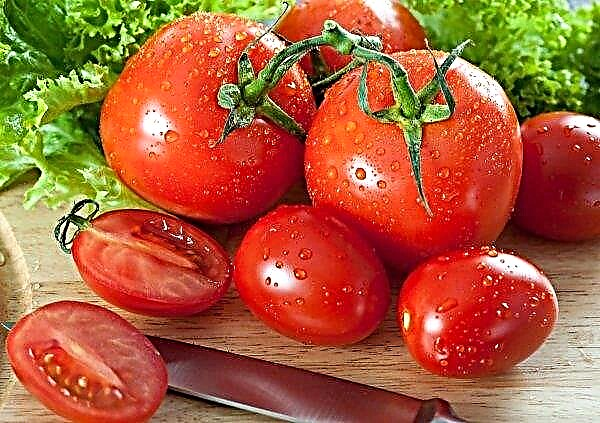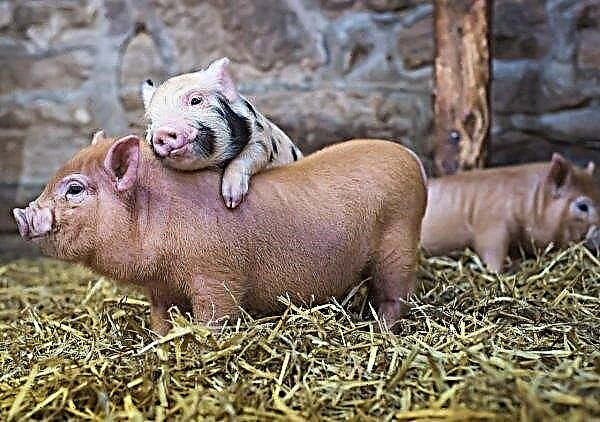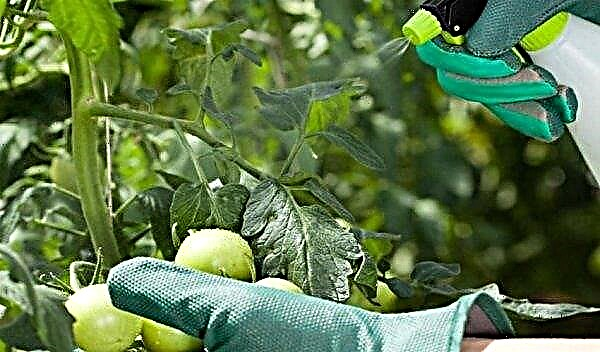Tomato "Princess" is considered one of the most popular among summer residents. It is characterized by versatility, high yields, large, fleshy fruits and unpretentiousness in cultivation. What else is able to please gardeners with the described variety and what are the features of caring for it - let's figure it out.
Characterization and description of the variety
Princess Tomato is a hybrid, indeterminate, large-fruited tomato variety that has an average growing season and is suitable for growing in greenhouses and open soil. These tomatoes showed the highest yield during greenhouse cultivation in mid-latitudes. The growing season is 100–110 days after transplanting. Subject to the basic rules of agricultural technology, the yield of the variety can reach 13–14 kg per 1 m².
Did you know? 1 cup of tomato fresh contains half the daily dose of ascorbic acid and vitamin A, required to actively strengthen the immune system.
This tall, up to 1.6 m, quite powerful plant, requiring mandatory garter. Bushes of medium branching, with large foliage of dark green color. During flowering, simple inflorescences are formed on the plant, which are converted into large, red, cylindrical fruits. The peel of the fruit is dense, smooth, shiny. The flesh is tender, rather fleshy, with an excellent sweetish taste. The weight of one tomato can reach 150–250 g.
Advantages and disadvantages
- Princess is an unpretentious tomato variety with the following advantages:
- undemanding and easy to care for;
- good resistance to ailments characteristic of solanaceous;
- excellent adaptation to new environmental conditions;
- universality;
- resistance to drought and to a decrease in temperature indicators;
- the ability to cultivate tomatoes in almost any climate zone;
- high productivity;
- excellent taste.
- The variety is also not without its shortcomings, among which vegetable growers note:
- the need for mandatory garter and stepsoning;
- the need to acquire new seed material every year.
Features of growing varieties
Despite the fact that the variety is unpretentious, in order to obtain high stable crops, one should adhere to several simple rules of agricultural technology when cultivating it.
Important! Since the Princess is a hybrid variety, it is impossible to collect its seeds on its own. Material for planting needs to be bought in special stores.
The necessary conditions
Tomatoes prefer to grow in a well-lit, well-ventilated place, where there is no direct sunlight and there are not a large number of other plantings nearby. Before planting seedlings, in about 2 weeks, the soil must be well loosened, dug up, fertilizer applied. Tomatoes grow well in the greenhouse, and can also bear fruit in an open garden. The optimum temperature indicators for the culture are +23 ... + 25 ° С in the daytime and at least +15 ... + 16 ° С - in the night. The best precursors for tomatoes are vegetables such as cabbage, carrots or onions - that is, not members of the Solanaceae family.
Seed sowing technology
Planting tomatoes, both in the garden and in the greenhouse, begins with growing seedlings. Sowing seeds for seedlings for greenhouses should be in the first weeks of February. For open soil, the sowing period must be calculated so that planting work is carried out after the seedling reaches 60–65 days. In regions with a warm climate, seedlings can be planted in April, in mid-latitudes - starting in the second half of May. In the northern regions with a short summer, tomatoes are grown only in greenhouses.
Preparation of seed material before sowing includes a number of standard measures:
- Germination test. The seeds are soaked in a weak salt solution for several hours: for planting, grains that remain at the bottom of the glass are selected - they are the highest quality.
- Treatment with stimulants. Selected seed material is immersed in a solution with any growth stimulant, which can be used as special store preparations, or alternative drugs, for example, aloe juice or honey, can be used.
Important! If purchased sowing mixture is used for sowing tomatoes, then you can skip the stage of its disinfection.
After preparation, the seeds are planted in separate containers - special peat cartridges, disposable cups, wooden or plastic boxes. For sowing, it is recommended to use light nutritious soil mixture with a neutral level of acidity, the main components of which can be humus and garden soil, mixed in equal proportions. Self-made soil should be decontaminated by calcining it in the oven for 20-30 minutes or spilling it with a weak solution of potassium permanganate.
Further technology for sowing seeds:
- fill the soil at the bottom of the tank and make small recesses up to 0.5 cm;
- place seeds in each hole, the distance between the grooves should be at least 3-4 cm, between grains - 1-2 cm;
- cover the crops with a thin layer of soil, moisten the surface with a spray gun.
Video: sowing tomato seeds
Seedling Care
Caring for sprouts is not particularly difficult and is based on the organization of such conditions:
- Temperature. The most comfortable indicators for seed germination are considered to be + 23 ... + 25 ° С during the day and not lower than + 18 ° С at night.
- Watering. So that the sprouts can hatch faster, it is necessary to moisten the seedlings moderately daily, spraying the soil with a spray surface.
- Top dressing. When sprouts reach 10 days of age, complex fertilizers should be applied. Also, mandatory feeding with liquid complex means should be carried out 7 days before the seedlings are planted in the ground. This will increase the immunity of the plant and will contribute to better adaptation in a new place.
Important! With intensive growth of green mass bushes, fertilizing with nitrogen fertilizers should be stopped and phosphoric preparations should be added, which stimulate the growth of fruits.
After the first shoots germinate, the container should be opened, and the temperature indicators reduced to + 21 ° C in the daytime and not lower than + 16 ° C - at night. As soon as 2-3 full leaves are formed on the seedlings, it must be dived into separate containers and pinch the main root stem.
Planting seedlings in the ground
The princess tomato variety is photophilous and prefers to grow in well-lit, sunny areas, reliably protected from direct sunlight, drafts and winds. The culture does not like crowding, therefore it is recommended to plant seedlings according to the scheme: no more than 4 seedlings per 1 m² with 1 stalk and no more than 3 shoots - with 2 stems. The experience of cultivating the variety showed that these tomatoes have the highest productivity when forming a bush of 2 stems. To plant seedlings in the ground, you need to make recesses in which to pour a handful of wood ash, which is necessary to protect the bushes from parasites and decay. Immediately after planting seedlings, it is recommended that the bushes be tied up.
The experience of cultivating the variety showed that these tomatoes have the highest productivity when forming a bush of 2 stems. To plant seedlings in the ground, you need to make recesses in which to pour a handful of wood ash, which is necessary to protect the bushes from parasites and decay. Immediately after planting seedlings, it is recommended that the bushes be tied up.
Care Features
One of the advantages of the described tomato variety is simplicity and undemanding care, which consists in timely watering, top dressing, the formation of bushes and weeding.
Did you know? From a botanical point of view, tomatoes are multi-nested paracarp berries, although in 1893 court in America recognized them as vegetables. However, since 2001, EU states have ordered the return of tomato fruit status.
Fertilizer and watering
Variety "Princess" is characterized by a rather high growth rate, therefore, needs good plentiful watering and top dressing. Irrigation of bushes should be carried out 2-3 times a week, until the topsoil is completely wet. It is recommended to moisturize in cloudy, morning or evening time, in order to avoid possible burns of leaves from exposure to direct sunlight. Do not use cold water for irrigation. Mandatory hydration of tomatoes is required during the flowering period, after loosening the soil and in the ripening phase of the fruit. In the conditions of greenhouse cultivation for irrigation of crops, experts advise organizing a drip irrigation system that allows you to control the level of moisture. For the full growth of the plant and the formation of fruits, it is necessary to regularly feed bushes using organic matter (litter, manure) or minerals based on phosphorus, potassium or nitrogen. Fertilizers need to be applied 1 time in 30 days, combining them with watering. The plant is especially acute in need of top dressing in the phase of formation and development of the fruit.
In the conditions of greenhouse cultivation for irrigation of crops, experts advise organizing a drip irrigation system that allows you to control the level of moisture. For the full growth of the plant and the formation of fruits, it is necessary to regularly feed bushes using organic matter (litter, manure) or minerals based on phosphorus, potassium or nitrogen. Fertilizers need to be applied 1 time in 30 days, combining them with watering. The plant is especially acute in need of top dressing in the phase of formation and development of the fruit.
Shrub formation and pinching
After rooting the plants, it is necessary to form bushes and trim the stepsons, otherwise it is not worth hoping for a rich harvest. As a rule, a bush is formed by:
- In 1 stalk. For this, all lateral processes are removed, and the stem is tied to a trellis or wooden pegs. Trimming the side stepsons is carried out when they reach a size of 5-6 cm. Removing stepchildren is carried out every 10 days. In parallel with this, the first blooming brush is cut, which allows to reduce the load on the bush and increase productivity.
- In 2 stems. Formation according to this scheme is carried out in the process of growing seedlings. For this, when a second full leaf is formed in the sprouts, pinch the top of the main stem. Stopping the growth of the main stem will allow the lateral processes to develop, which can subsequently replace it. It is possible to carry out the formation of a bush even after planting seedlings - in this case, the plant leaves 1 dense stem and 1 lateral, the strongest process, on which 5 flower brushes have formed.

Soil cultivation and weeding
A mandatory procedure for the care of the Princess is considered to be loosening of soil and weeding from weeds. The first event allows you to:
- saturate the soil with oxygen and nutrients;
- create favorable conditions for warming the soil;
- intensify the growth of culture.
The first cultivation is recommended to be carried out immediately after planting, delving into the soil by 10–12 cm. Subsequent cultivation procedures are carried out after irrigation to a depth of 4–5 cm. Weeding is recommended to be carried out as necessary. However, it is important to do this before the weeds bloom.
To prevent the appearance of parasitic plants, it is recommended to cover the bed with tomatoes with a layer of mulch - sawdust, straw, hay. Mulching will also make it possible to preserve moisture in the ground and protect the plant from possible negative climatic phenomena, and simplify the process of watering the bushes.
Diseases and Pests
The Princess is characterized by good resistance to ailments and pests, which most often affect the plants of the Solanaceae family. However, non-compliance with the main rules of agricultural technology can lead to damage to the bushes with tobacco mosaic, gray spotting, late blight.
To prevent the development of diseases it is necessary:
- not to allow excessive wetting of the plant, which can provoke rotting of the root system, drying out and yellowing of foliage;
- regularly carry out loosening of the soil, weeding weeds;
- be sure to observe crop rotation;
- to apply fertilizers at the indicated time;
- periodically carry out decontamination of bushes using biologics, for example, Fitosporin, which protects tomatoes from fungal infections and viruses.
For the control and prevention of pests, the use of folk remedies is allowed:
- treatment of bushes with garlic water or whey allows you to fight late blight;
- a solution of ammonia is an excellent remedy against slugs;
- spraying with soapy water protects against aphids;
- potassium permanganate solution helps get rid of tobacco mosaic.

Harvesting and storage
Harvesting tomatoes should be carried out as the fruit ripens. As a rule, the cleaning time falls on the period from August to September. Experienced gardeners are not advised to keep a heavy crop on the bushes for a long time, since this leads to weakening of the plant. If tomatoes are planned to be transported, it is allowed to collect unripe fruits, which lend themselves perfectly to transportation, ripen well in the home, and retain their aesthetic and taste.
The entire crop must be harvested if there is a threat of cooling to + 5 ° C. For long-term storage, fruits that are dense, not wrinkled, without visible damage and rotten areas are suitable. Collected tomatoes can be stacked in cardboard or plastic boxes, the bottom of which is lined with clean paper or dry hay.
The optimum conditions for the preservation of fruits are considered to be temperature + 10 ... + 12 ° C and relative humidity of 80–85%. At the same time, the room should be well ventilated and protected from direct sunlight. Under such conditions, tomatoes can be stored for 2.5–3 months.
Recommendations for the use of varieties
Tomatoes of this variety have excellent taste, which are evaluated by vegetable growers by 4 points out of 5. That is why the fruits are widely used raw, as raw materials for the preparation of salads, appetizers, vegetable dishes, sauces, ketchups. They are suitable for canning and pickling, preparation of salad preservation. Due to its rich taste, meatiness and pleasant aroma, these tomatoes add piquancy to cooked dishes.
"Princess" is rightfully considered one of the best varieties of tomatoes of medium maturity, with consistently high yields. These tomatoes are undemanding in care and cultivation, are not afraid of changes in temperature conditions, are resistant to many diseases. The described culture will be an excellent promising option for beginner gardeners.

